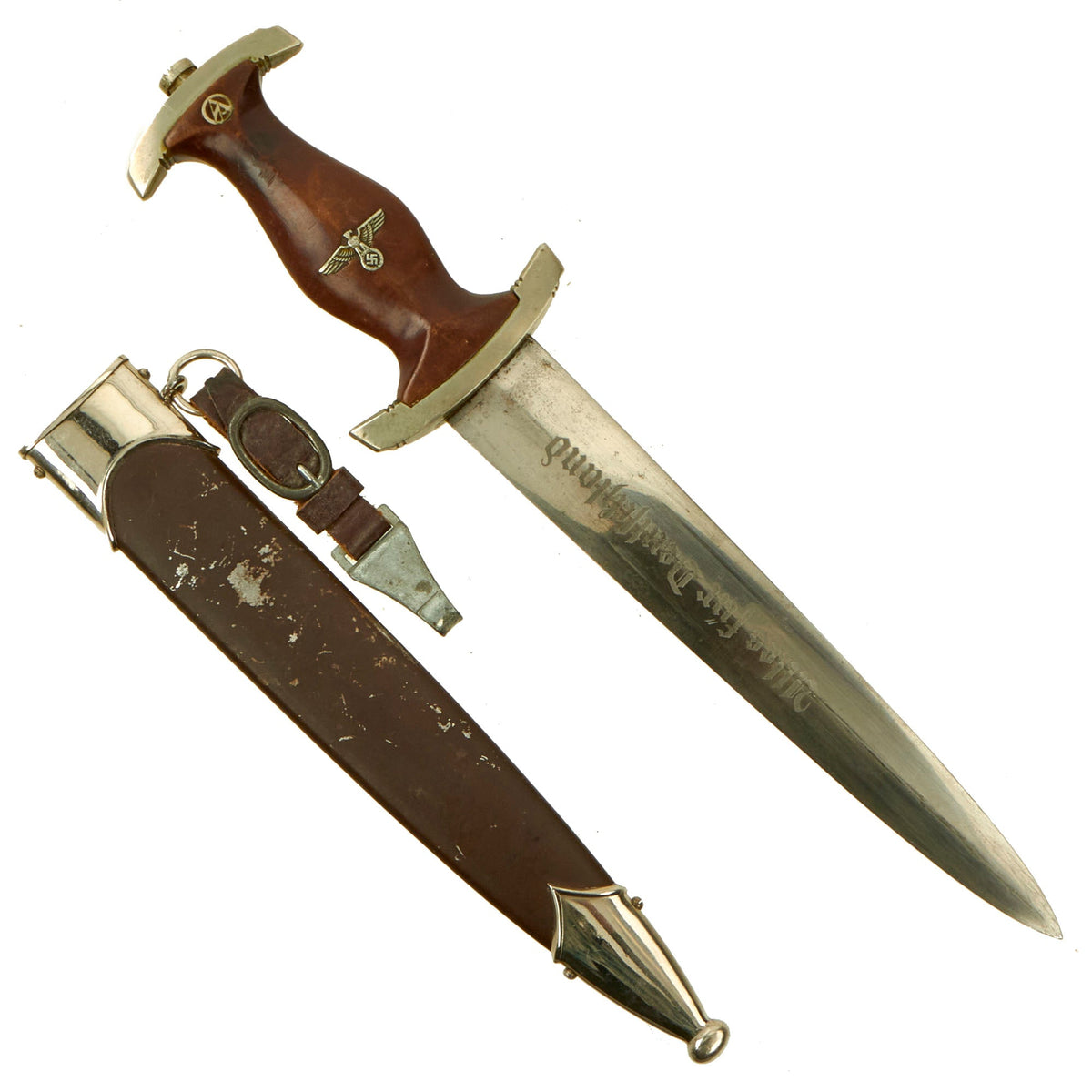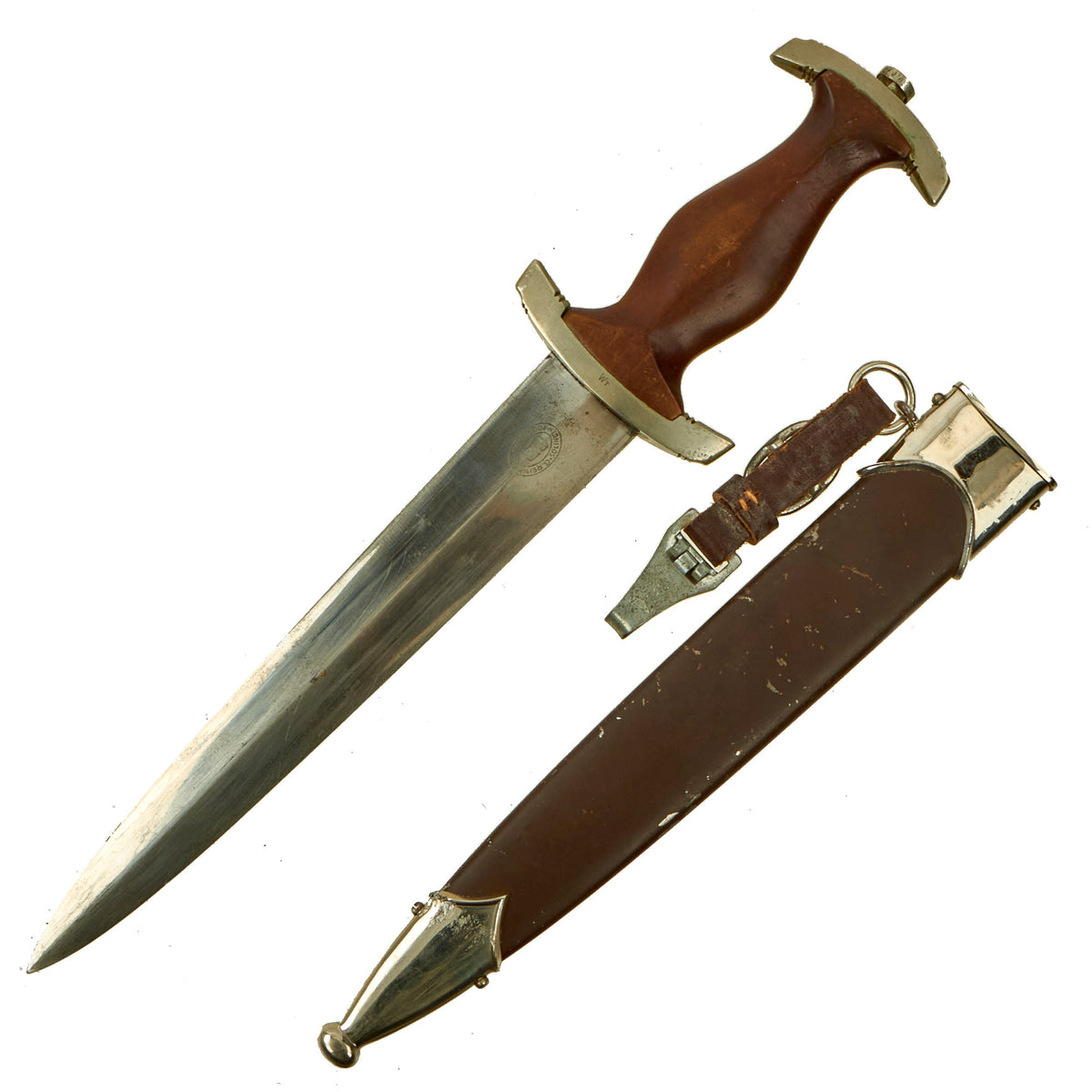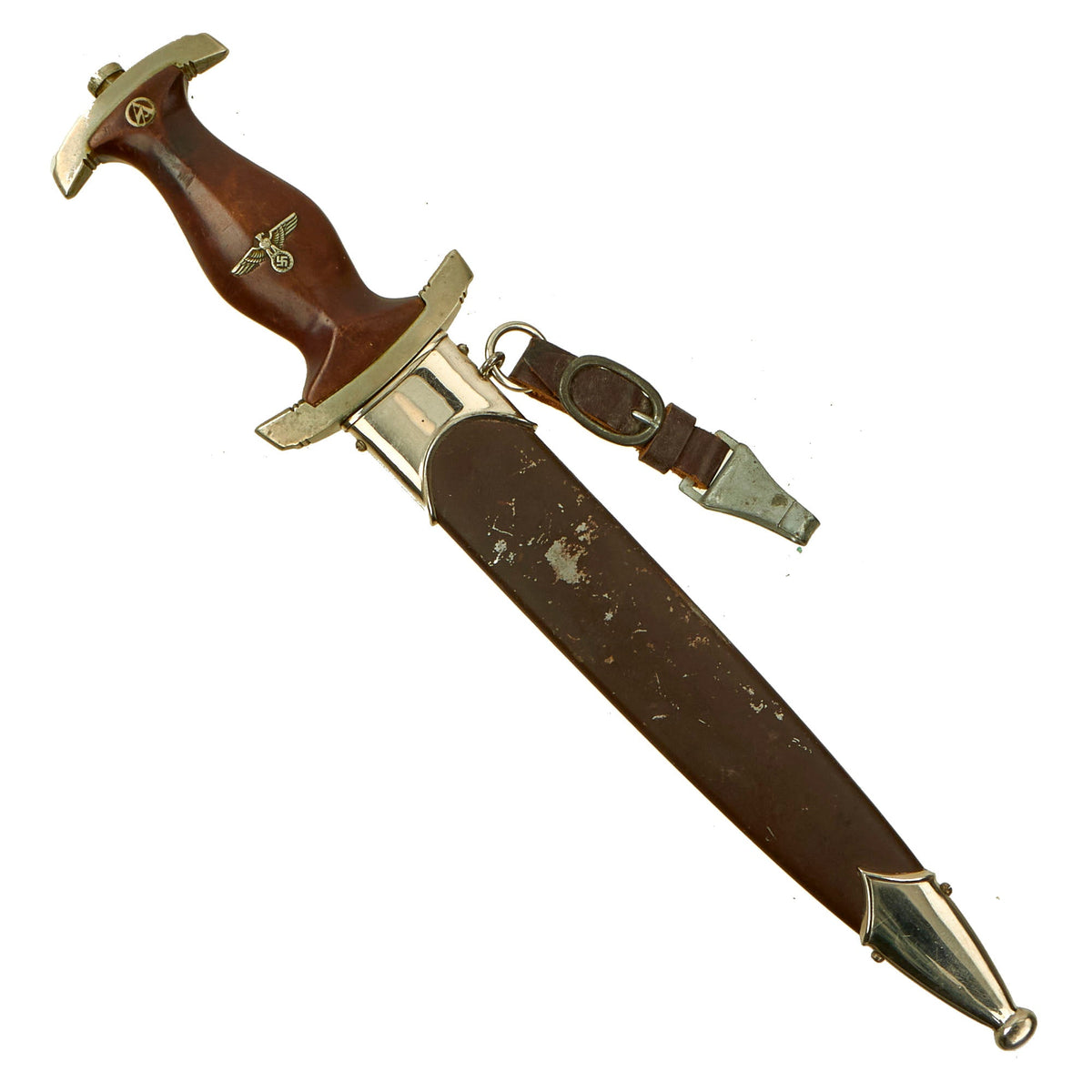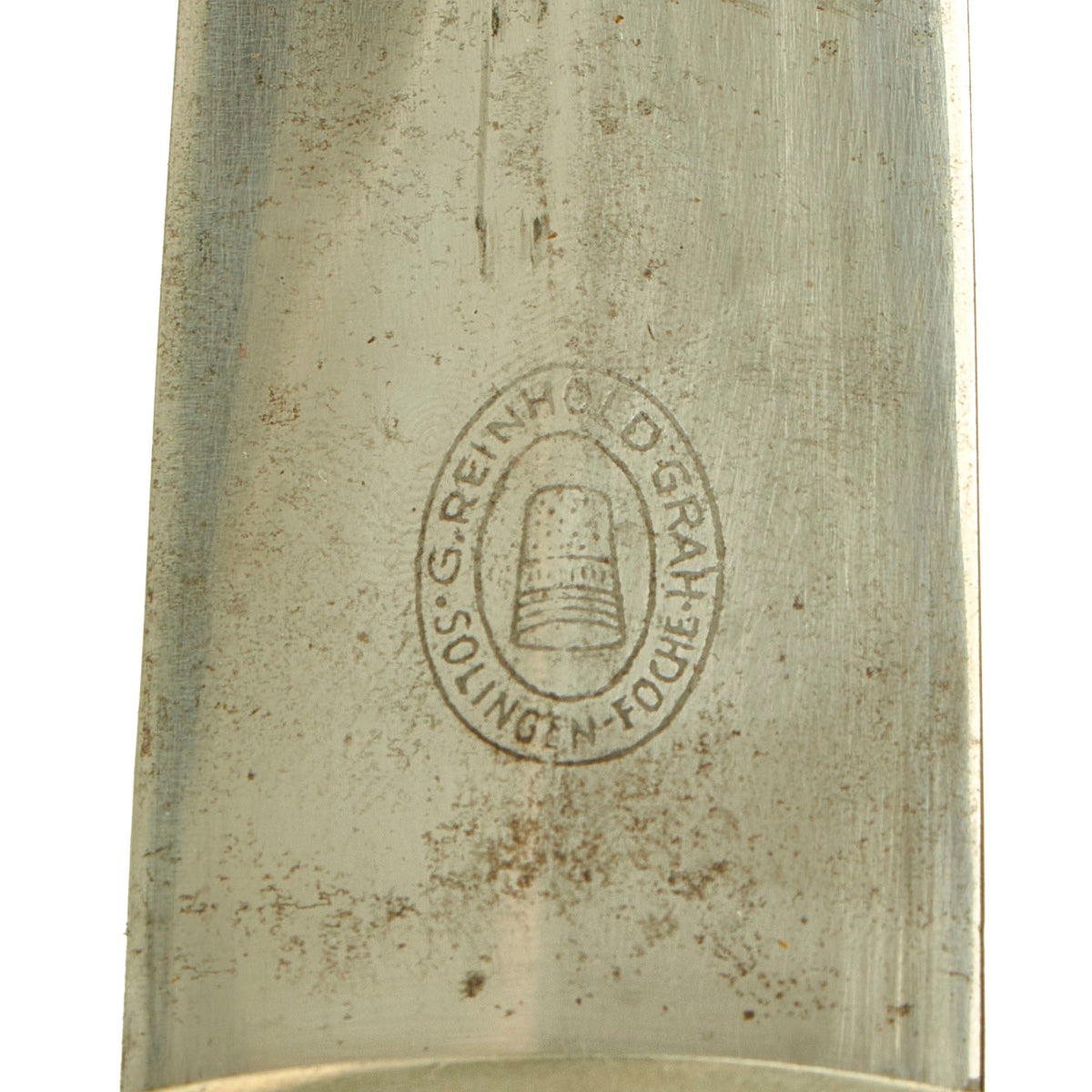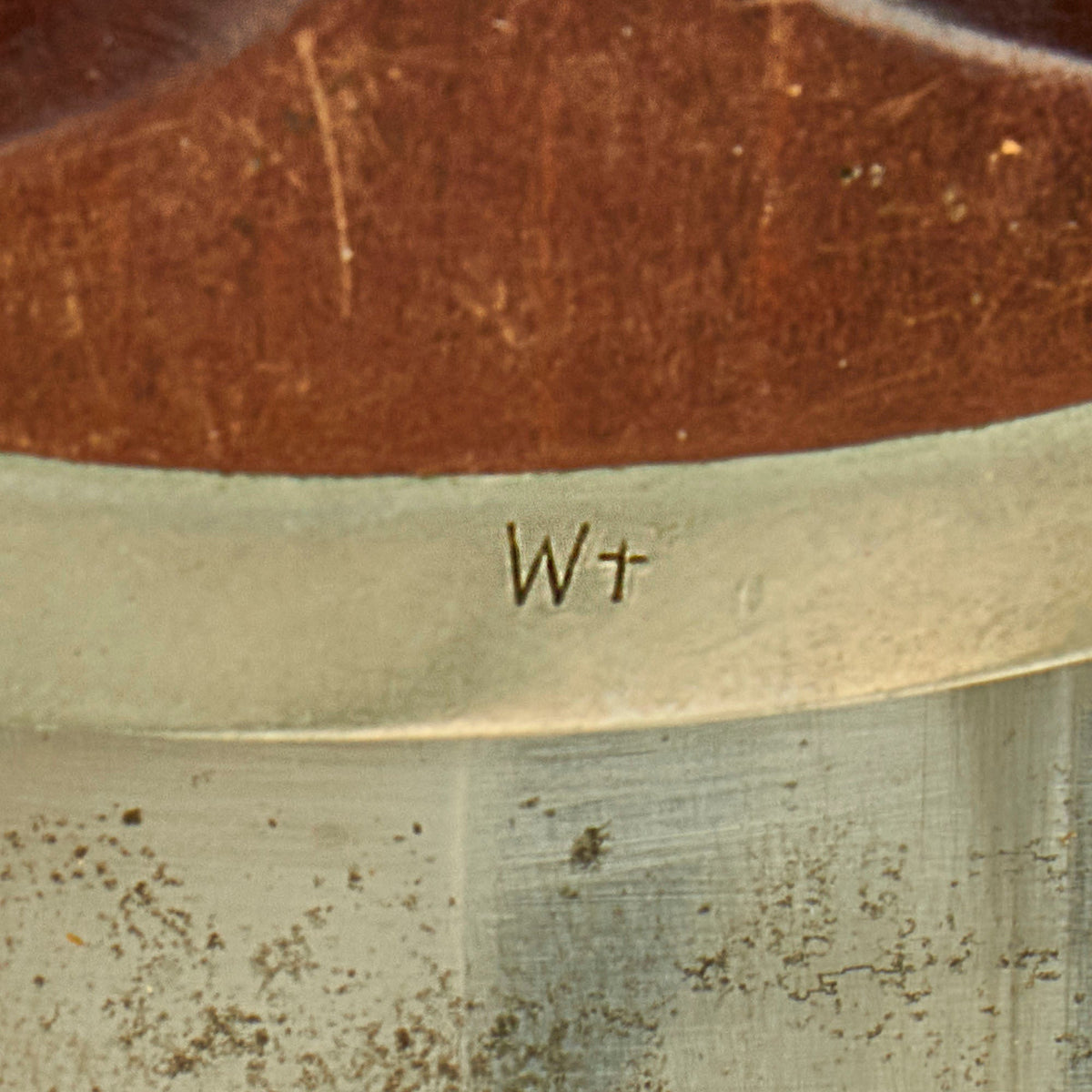Original German Early WWII SA Dagger by Rare Maker Gust. Reinhold Grah of Solingen-Foche with Scabbard & Hanger Original Items
$ 995,00 $ 248,75
Original Item: Only One Available. This is an very good condition early pattern SA Dagger, made by the very rare firm of Gust. Reinhold Grah, Stahlwarenfabrik (Steelware Factory), located in the Foche district of Solingen, the legendary “City of Blades” in Western Germany. This company is known for making early pattern SA daggers, but only made them in limited numbers. It comes comes compete with an original scabbard, which is a later war replacement, complete with a leather hanger.
The dagger has solid nickel silver fittings throughout, and is a very nice example. The crossguards and tang nut are in very good condition throughout with all fittings having a nice lightly aged patina. There is some age to these mounts but there is no lifting anywhere, showing that they are solid and not plated. They show only light wear with just a bit of light denting and scratching. The lower reverse guard is Gruppe/Gau marked Wf, for Westfalen (Westphalia), which encompassed the area near Cologne, very close to Solingen. This feature was only seen on daggers produced 1935 and prior.
The grip is a fine product having a lovely mahogany red brown color, with medium center ridge construction, with some light wear and a few small dents. The grain is lovely on this example, with some great color variation. It has what looks to be a thin varnished finish, with a bit of discoloration on one area. This grip is in very good condition and fits the crossguards nicely, with some cracks on both sides by the pommel guard. The pommel nut does show turning on the outside due to not using the correct tool, and there is a bit of wiggle in the blade / hilt connection.
The SA symbol button is still nicely set, and still has most of the translucent enamel intact, with the nickel plating showing some oxidation. The grip eagle is a fine example being the style with beak that points straight. It has some nice antiquing and patination on it, showing that it is solid nickel alloy, and it has patinated nicely. The details are still there to the eagle to include the beak, breast feathering, wing feathering, talons, wreath and mobile swas (hook cross).
The blade is in very good condition, still showing much of the original factory final grind cross grain on both sides. This texture is iconic, and is the definitive identifying characteristic for a real WWII German Blade. There does look to have been some past minor staining, which has been removed by cleaning and runner wear, though this has made the cross grain a bit faint. However the blade still really does look great, and better than most that we see. The acid-etched Alles für Deutschland (Everything for Germany) SA motto is crisp, with the factory darkening retained at about 50%.
This fine example was produced by very rare maker Gust. Reinhold Grah, Stahlwarenfabrik (Steelware Factory), located in the Foche area of Solingen. The rear of the dagger is marked with the company’s trademark “Fingerhut” (thimble) logo inside an oval “losenge” with the maker name and address:
G. REINHOLD GRAH
* (Logo) *
SOLINGEN-FOCHE
According to J. Anthony Carter’s book, GERMAN KNIFE AND SWORD MAKERS, this company was founded in the late 19th century, and registered with Solingen authorities in 1901. They opened a branch office in Remscheid, and made knives, forks, and spoons, as well as military- and pocket knives. Their third reich production however was limited to a few early period SA daggers with the oval losenge logo around the Thimble trademark. The company survived the war, relocating to Solingen-Gräfrath in 1952, and eventually moving entirely to Remscheid.
The later war replacement scabbard shell is straight throughout and has very good original brown paint, which is matte and not the usual gloss. It has just a bit of scuffing and the usual crazing and checking in the finish, with only small areas of finish damage. The scabbard shell is equipped with fine matching plated steel mounts, which show only light wear and oxidation, though the bottom “ball” has a few small dents They nicely match the crossguards and are complete with all four dome head screws.
Attached to the hanger loop is a very nice leather hanger with a plated steel buckle, with the leather in very nice condition, showing just a bit of wear. The plated steel clip on the end is marked with RZM code M5/71 for Overhoff & Cie. of Lüdenscheid, whose OLC in a diamond trademark is also present.
A very nice early war SA dagger from a rare maker, complete with a replacement original scabbard and belt hanger.. Ready to display!
Specifications:
Blade Length: 8 3/4″
Overall length: 13 3/4”
Crossguard: 3”
Scabbard Length: 10”
History of the SA-
The SA or Brown Shirts, were a private political formation which Adolf AH and the NSDAP used to maintain order at organized Party meetings and demonstrations. The group was formed in 1921, and grew to a huge force of nearly 3,000,000 men by the later 1930’s. To instill esprit de corps, as well as create employment for the Blade City of Solingen, it was decided each SA man would carry a dagger with his Brown Shirt uniform. Huge quantities needed to be produced to accommodate the demand. The dagger initially was produced of hand-fitted nickel mounts with attractive finished wood grip and brown anodized (a bluing process) finished scabbard.
The blade was etched with the SA motto, Alles für Deutschland. Examples produced prior to 1935 were stamped with the German sector of the SA group on reverse lower crossguard. Later examples underwent standardization through the RZM ministry. These pieces were produced of cheaper plated zinc-base fittings and scabbards were simply painted brown.
Prior to his “unmasking” as a traitor, Ernst Röhm was the leader of the SA. In 1934, he distributed approximately 100,000 SA daggers with his personal inscription on the reverse blade. These daggers were to honor individuals who had served with the SA prior to December, 1931. Other than the inscription, these pieces were identical to the standard M1933 SA dagger. After the Röhm purge, the inscription was ordered to be removed. Many examples were returned to the factory for grinding. Others were simply ground in the field by whatever means were available. Examples will occasionally be encountered with remnants of the original inscription remaining on the blade, but mostly none will remain. Some blades exist with an intact inscription, reflecting only the removal of the Röhm signature. Very very rarely is an example seen with a full, untouched inscription, as the holder would have surely risked a charge of treason.
Fast Shipping with Professional Packaging
Thanks to our longstanding association with UPS FedEx DHL, and other major international carriers, we are able to provide a range of shipping options. Our warehouse staff is expertly trained and will wrap your products according to our exact and precise specifications. Prior to shipping, your goods will be thoroughly examined and securely secured. We ship to thousands clients each day across multiple countries. This shows how we're dedicated to be the largest retailer on the internet. Warehouses and distribution centres can be located throughout Europe as well as the USA.
Note: Orders with more than one item will be assigned a processing date depending on the item.
Before shipping before shipping, we'll conduct a thorough inspection of the items you have ordered. Today, the majority of orders will be delivered within 48 hours. The delivery time will be between 3-7 days.
Returns
The stock is dynamic and we cannot completely manage it because multiple stakeholders are involved, including our factory and warehouse. So the actual stock may alter at any time. It's possible that you may not receive your order once the order has been made.
Our policy is valid for a period of 30 days. If you don't receive the product within 30 days, we are not able to issue a refund or an exchange.
You can only return an item if it is unused and in the same state as the day you received it. You must have the item in its original packaging.
Related products
Uncategorized
Uncategorized
Uncategorized
Uncategorized
Uncategorized
Australian WWII Owen MK1 Machine Carbine SMG Custom Fabricated Replica with Sling Original Items
Uncategorized
Armored Burgonet Helmet & Polearm from Scottish Castle Leith Hall Circa 1700 Original Items
Uncategorized
Angolan Rebel 1970s era 60mm Inert Display Mortar from Angolan Civil War Original Items
Uncategorized
Uncategorized
Uncategorized
Uncategorized
Uncategorized
Uncategorized
Uncategorized
Uncategorized
Uncategorized
